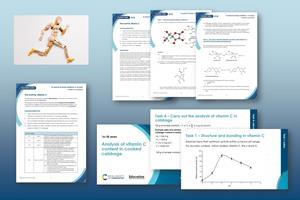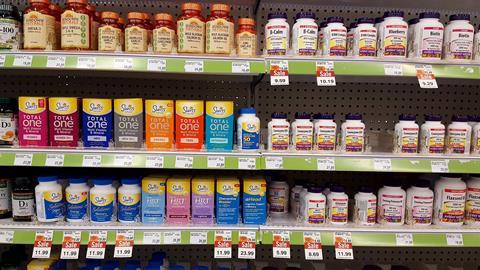Explore the chemical composition of supplements and find out if they really are vital
In 17th century London, doctors noticed increasing numbers of children with a disease called rickets. Rickets affects children’s bones, making them softer and weaker than they should be and sometimes causing children’s legs to bend together or apart too much at the knees. Back then, doctors didn’t know why it was happening, but they suggested it was to do with diet: perhaps children were being fed too much meat or not enough milk.

Research suggests that diet was at least partly to blame. Having very low levels of calcium, which we get from milk and other dairy products, can contribute to rickets and can be fatal if left untreated. But there may be another reason why London became such a hotspot for rickets. At that time, people were starting to burn coal as fuel and the city air was thick with pollution. The smog may have obscured the sunlight needed for children’s bodies to make vitamin D, a crucial nutrient for growing bones.
In the past, diseases caused by nutritional deficiencies were commonplace because we didn’t understand that getting the right nutrients, including vitamins and minerals, is not just crucial to growth but to our overall health and well-being. Scurvy is another example. Often identified by bleeding gums, it affected sailors, who couldn’t get enough vitamin C from their limited diets at sea. Although 17th century doctors realised that the disease could be cured by drinking lemon juice or eating fresh fruits, they didn’t know why.
Today, there is a multi-billion-dollar industry based around supplements to combat any type of ailment or deficiency, though some of the claims that supplement manufacturers make can be regarded as dubious. It’s hard to get a handle on exactly what is in all the different supplements and whether they work. But let’s take a look at some of the most common vitamin supplements, what’s in them, how they’re made and whether we need them.
In your class
We can use the essential analytical chemistry technique of titration to calculate the amount of vitamin C in dietary sources. However, it isn’t as simple as testing the unprocessed food to discover the vitamin C intake. Vitamin C is water-soluble, so the method of preparing or cooking can affect the amount of the vitamin that makes it to your dinner plate. Challenge learners to devise a method to compare the amount of dietary vitamin C in cabbage cooked via two different methods. Can this be applied to the preparation of other dietary sources of vitamins to maximise their nutritional value too?
Vita-amines
Vitamin supplements are modern substitutes for natural chemicals that, until the 20th century, we could only get from our food. The B vitamins, for example, are a range of different chemical compounds found in everything from walnuts and wheat to liver and lentils. Though we only need small amounts of these chemicals, they are essential for our bodies to function properly. Initially, all vitamins were thought to be chemically similar. ‘They used to be called “vita-amines”, because they were [all thought to be] amines,’ says University of Surrey nutritionist, Sue Lanham-New. Vitamin B1 (thiamine) fit this thinking when it was discovered in 1912, as it contains an amine group. More generally, however, it turned out not to be the case. Despite this, the name stuck and vita-amines (combining vita, meaning vital for life, and amines) became vitamins.
An important side note is that both the name vitamin and its definition can be a little confusing in relation to vitamin D, which isn’t an amine and isn’t only found in our food. In fact, says Sue, ‘We only called it vitamin D because we found it after A, B and C.’ Vitamin D is better defined as a prohormone – a chemical that can be converted into a hormone. And while we can get it from foods like eggs and mushrooms, most of it comes from our own bodies instead. In our skin, vitamin D3 is made when the UV radiation in sunlight converts a steroid chemical called 7-dehydrocholesterol into its active form.

Download this
Context-based problem-solving practical activity, for age range 16–18
Plan a redox titration to investigate the effect of cooking methods on vitamin C in cabbage.
Resources include:
Download this
Practical activity, for age range 16–18
Use this context-based problem-solving activity to compare the vitamin C in boiled cabbage cooked via two different methods. Learners will plan a titration and analyse the amount of vitamin C in samples cooked using the two methods.
Download the resources from the Education in Chemistry website: rsc.li/3Feqube
Natural or artificial
So, if vitamins are naturally occurring chemicals, what are vitamin supplements? As substitutes, they can come from natural or artificial sources. This means they are either extracted from plants or animal products (natural) or they are made in the lab (artificial) using other chemicals as starters. Vitamin A, for instance, is made from beta-ionone, which was originally sourced from lemongrass oil. During the Second World War it became difficult to get hold of the citrus-smelling oil, so chemists began using other synthetic building blocks to make beta-ionone. One route is from acetone, the chemical in nail polish remover.

Vitamins can also be extracted from specialised microbes (bacteria or yeast) engineered to act as miniature vitamin factories. This method can be more environmentally friendly than methods based on chemical synthesis, which tend to require lots of energy and can cause pollution. There are already processes for producing vitamins A, B, C, D, E and K in microbes, although some still need to be improved before they can be used commercially.
While the chemicals themselves can be produced in different ways, the finished vitamin or multivitamin supplements are produced by a machine that compresses powdered ingredients into pills (or capsules). The correct quantity of each ingredient is painstakingly calculated to ensure supplements meet the dietary reference values or recommended intakes for the relevant vitamins, as well as regulations in each country where they are sold.
Supplementary benefits
If vitamins are supplements for chemicals that we can get from food, do we need to take them at all? In the past, we weren’t always able to access all the foods we needed, but is this still the case today or are we just taking supplements because it’s easier?
These are tricky questions, because while we may think that we have access to lots more foods today than people did in the 17th century, not everyone may be able to afford them or want to eat them. And some people may have lifestyles or health conditions that make them more likely to be deficient in certain vitamins.
Vitamin D is a particularly interesting case because our bodies can make it, assuming we get roughly 20 minutes of sunshine a day. Sue, however, is firmly of the belief that, in the UK, we all need to take a vitamin D supplement because our bodies can’t make enough of it all year round. In fact, she was a member of the Scientific Advisory Committee on Nutrition when it put together guidelines for the government on the subject, resulting in the daily recommendation for vitamin D changing from zero to ten micrograms per day. ‘It was zero – it was deemed that we didn’t need vitamin D in our diets because sunlight was enough,’ she says. ‘What we showed was that was flawed thinking. Yes, during the summer, if you get out in the sunlight, you don’t need it in your diet. But in the winter, you do.’
More resources
- Put Vitamin C in context, discussing how fresh orange juice degrades, and the roles of oxidation and refrigeration to help teach rates of reaction at post-16.
- Do vitamin pills work? Analyse data about the effects of vitamin C and explore how science can give rise to different viewpoints in this lesson plan with activities for 14–16 year olds.
- In this experiment, learners use titration to discover the vitamin C content of their favourite fruit drink.
- Show students how a senior laboratory technician ensures food products meet legislative requirements and are safe for people with allergies.
More resources
- Put vitamin C in context, discussing how fresh orange juice degrades, and the roles of oxidation and refrigeration to help teach rates of reaction at post-16: rsc.li/3tttRs4
- Use this 14–16 lesson plan and activities to analyse data about the effects of vitamin C and explore how science can give rise to different viewpoints: rsc.li/3ZTP3Ur
- Use titration to discover the vitamin C content of learners’ favourite fruit drinks: rsc.li/3trKfcL
- Show your students how a senior laboratory technician ensures food products meet legislative requirements and are safe for people with allergies: rsc.li/45sMkSI
Meanwhile, some recent studies have suggested that taking vitamin D supplements doesn’t reduce the risk of bone fractures, or other health conditions like heart disease and type 2 diabetes. But Sue explains that as most studies are carried out in people with healthy levels of vitamin D, they don’t pick up the real benefits of supplements. By contrast, some of her own team’s studies in the Middle East focus on women who wear veils, which shade them from sunlight and lead to levels far below what is considered deficient. Sue says more studies are needed in these populations and in people who have darker skin, which needs to absorb more UV light to make the active form of the vitamin.
Athletic advantage?

One group that you might not associate with vitamin deficiencies is elite athletes. We think of athletes as some of the healthiest people on the planet. But as Kathryn Beck, a registered dietitian and nutrition researcher at Massey University in New Zealand, explains, there are lots of athletes whose activity levels mean they need to take in more energy than the average person. These athletes may also have increased demands for vitamins and minerals. Although they could get all the vitamins they need by eating more food and having a well-balanced diet, many athletes do decide to take supplements. So, what does a dietitian think about this? ‘If athletes are eating well, there is no evidence that extra vitamins will help to improve performance,’ Kathryn says. ‘However, some athletes may benefit from taking vitamins. For example, athletes who have a diagnosed vitamin or mineral deficiency, or those who are on an energy-restricted diet.’ The latter includes athletes who, in some sports, reduce their energy intake for a period before a competition to make a certain weight category.
When it comes to athletes, vitamin D supplementation is, again, an interesting example. Kathryn’s own research highlights the increased rates of vitamin D deficiency in athletes, like gymnasts, who train indoors, due to their lack of exposure to sunlight. In general, though, she sticks to the principle that a balanced diet is best, not least because, she says, ‘There are lots of good things in food – some probably yet to be discovered – that are difficult to replicate in supplement form.’ But athletes must also avoid taking any supplement that could contain substances classed as performance-enhancing and would therefore be banned by anti-doping authorities. There have been plenty of high profile cases, across different sports, where athletes have claimed that supplements containing banned chemicals have jeopardised their sporting careers.
While we are not all athletes, it’s probably no bad thing to aim to get most of our vitamins from food but supplements are a modern solution for those who need them. On the other hand, it’s not always clear who those people might be. Who you are and how you live influences your vitamin requirements so scientists are still trying to work out which groups could benefit the most from a top-up.
Article by freelance science writer and editor Hayley Bennett. Resource adapted from the book In search of more solutions by Nora Richardson















No comments yet